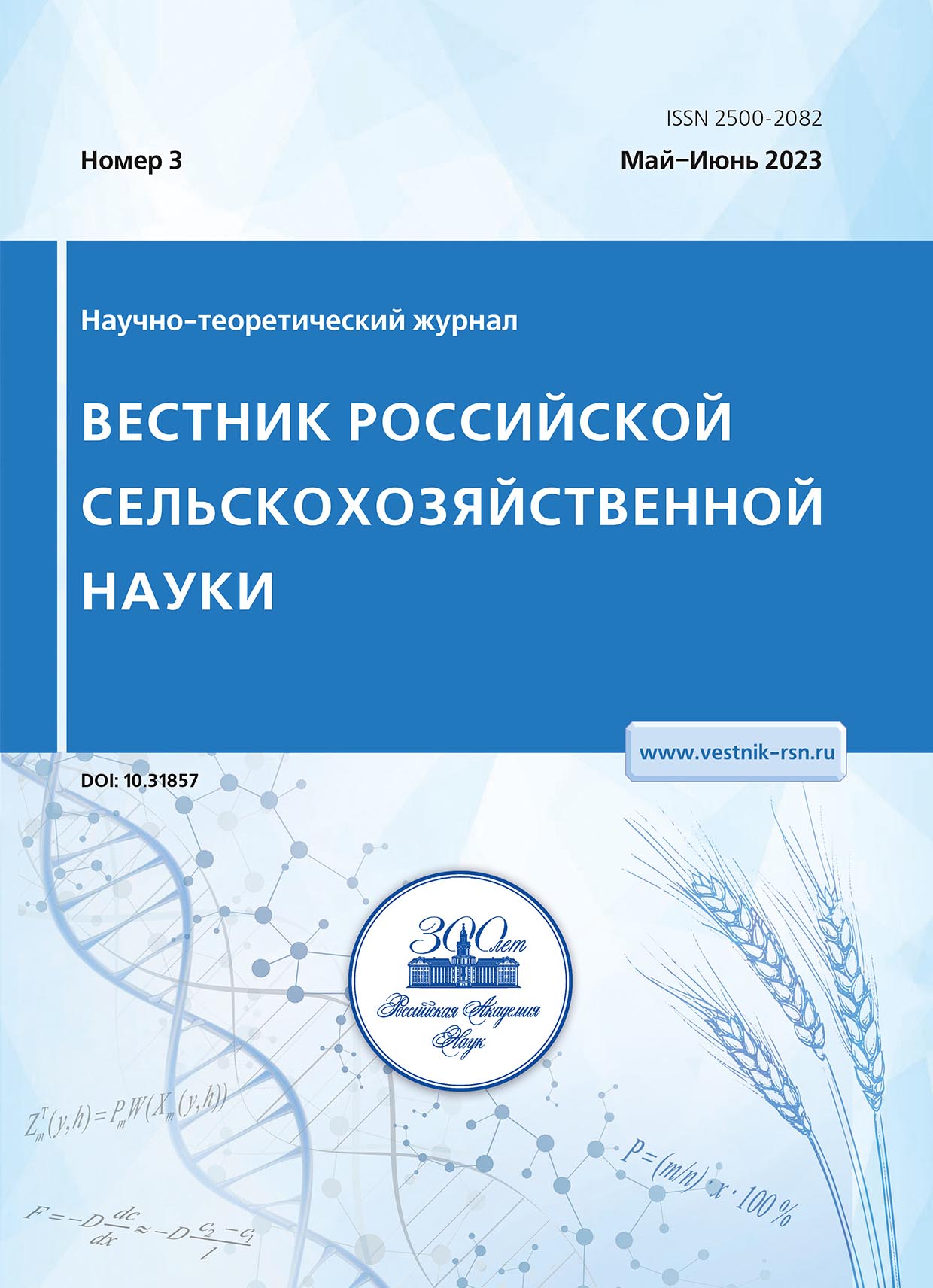EVALUATION OF GENETIC MARKERS IN THE ANALYSIS OF THE COLORS AND MARKS OCCURRENCE IN THE VYATKA BREED HORSES
Abstract
Vyatka breed is a valuable small native breed of horses. The study of the determination of suits is of significant practical importance in breeding. This is especially true for small breeds. The purpose of the research is to monitor the color and markings as important genetic markers of preservation the Vyatka breed gene pool. To meet the objective, the following tasks were set: to evaluate the structure of suits in a microevolutionary aspect and to study the polymorphism of the MC1R and ASIP genes, determine the basic suits, the “lightening” genes TBX3 and MATP, determining the desired suits in the breed, as well as to evaluate the influence of the TBX3 and W20 genes, giving the desirable "wild" markings and undesirable whites. The object of the study is Vyatka horses born in 1975-2022 (n=2949) registered in the breed database. DNA extraction from hair follicles of Vyatka horses (n=86) was carried out in the “HorsGen” laboratory (Moscow) using “ExtraGene DNA Prep” (“Isogen”, Moscow). Single nucleotide polymorphisms (SNPs) were identified by allele-specific PCR. The calculations were performed using MS Excel 10. Prevailing colors in the Vyatka breed – dun (56.9%) and grullo (31.7%). Of commercial interest are the colors determined by the Dun + Cream genes (3.2%). The occurrence of the D/D genotype in the Vyatka breed is low (0.167), so there are non-dun colors (5,2%). All TBX3 genotypes were identified with a predominance of D/nd1 (0.405). The relationship between the TBX3 gene and white markings has not been found, but with a shade of color and “wild” markings, it has been identified. The D/nd1 genotype is more common in medium (0.440) and light (0.714) horses, with D/nd2 (0.455) predominating in darker individuals. Noticeable "wild" markings prevail in horses with the D/nd1 genotype (0.539), their absence was found only in species with D/nd2. The MC1R/EE genotype is predominant in horses without white markings (0.612) and those with small markings (0.500). The occurrence of the W20 allele in Vyatka breed is low (0.146) and affects the size of white marks: the lowest was noted in animals without marks, the highest - with large marks. Since the color is an important genetic marker and selection trait, genotyping of breeding stallions and mares for the set of genes associated with the colors and markings is important.
References
2. Belousova N.F., Bass S.P. Proyavlenie i raspredelenie depigmentirovannyh oblastej u loshadej vyatskoj porody i ih vliyanie na ocenku plemennyh zhivotnyh // Konevodstvo i konnyj sport. 2020. №3. S.22-25. doi: 10.25727/HS.2020.3.62768.
3. Borisova A.V., Hrabrova L.A. Detekciya mutacii PMEL17 i serebristoj masti u loshadej sovetskoj tyazhelovoznoj porody // Konevodstvo i konnyj sport. 2015. № 3. S. 12-14. EDN WNDGGJ.
4. Burenko A.V., Gopka B.M. Mast' i rezvost' loshadej Orlovskoj rysistoj porody // Nauchno-tekhnicheskij byulleten' Instituta zhivotnovodstva Nacional'noj akademii agrarnyh nauk Ukrainy. 2019. №121. S.75-86. doi: 10.32900/2312-8402-2019-121-75-86.
5. Kalinkova L.V. Izuchenie polimorfizma genov ASIP i MC1R u loshadej arabskoj porody // Genetika i razvedenie zhivotnyh. 2020. №2. S.50-53. doi:10.31043/2410-2733-2020-2-50-53
6. Kalinkova L.V., Zajcev A.M., Ivanov R.V. Geneticheskaya struktura lokal'noj populyacii loshadej yakutskoj porody po genam MC1R, ASIP, DMRT3 i MSTN // Sel'skohozyajstvennaya biologiya. 2022. №57 (2). S.272-282. doi: 10.15389/agrobiology.2022.2.272rus
7. Kurskaya V.A. Masti loshadej. Moskva, 2011. 442 s.
8. Hrabrova L.A., Blohina N.V., Belousova N.F., Kotran E.G. Ocenka genealogicheskoj struktury vyatskoj porody loshadej (Equus ferus caballis) c ispol'zovaniem analiza DNK // Genetika. 2022. №58(4). S.457-462. doi: 10.31857/S0016675822040063
9. Bailey E.F., Brooks S.A. Horse genetics. CABI, 2020. 248 s.
10. Belousova N.F., Bass S.P., Zinoveva S.A. et al. Features of coat color and markings and impact of dun factor on Vyatka horse breed. In International Scientific-Practical Conference Agriculture and Food Security: Technology, Innovation, Markets, Human Resources (FIES 2019), Kazan, 13-14 Nov. 2019. Kazan, PP. doi: 10.1051/bioconf/20201700202.
11. Hauswirth R., Hauswirth R., Jude R. et al. Novel variants in the KIT and PAX3 genes in horses with white-spotted coat colour phenotypes // Animal Genetics. 2013. No. 44(6). PP. 763-765. doi: 10.1111/age.12057. PMID 23659293.
12. Imsland F., Imsland F., McGowan K. et al. Regulatory mutations in TBX3 disrupt asymmetric hair pigmentation that underlies Dun camouflage color in horses // Nature Genetics. 2016. No. 48(2). PP.152-158. doi: 10.1038/ng.3475.
13. Librado P., Fages A., Gaunitz C. et al. The evolutionary origin and genetic makeup of domestic horses // Genetics. 2016. No. 204(2). PP. 423-434. doi: 10.1534/genetics.116.194860.
14. Reißmann M. Die Farben der Pferde. 2009. P. 272. ISBN: 978-3-86127-460-5
15. Sponenberg D.P., Bellone R. Equine color genetics. Hoboken: Willey-Blackwell, 2017. 352 s.


